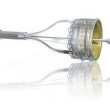1) The CULPRIT-SHOCK Study Is Finally Published in NEJM and It Is Bound to Change Guidelines During SOLACI’s coverage of the TCT 2017 Congress in Denver, Colorado, we already mentioned some of the outcomes of this study that has arrived to revolutionize clinical practice, given the differences between its results and those of the classic SHOCK trial, which has marked...
Surprising Prognosis for Normal ACS
St elevation acute coronary syndromes are typically caused by thrombotic obstruction of a coronary artery due to ruptured atherosclerosis plaque. However, there is a significant number of patients with similar clinical presentations but no evidence of obstructive coronary artery disease (CAD). Read also: CTO in patients with acute myocardial infarction increases long term mortality. In general, patients without...
Cost-Effectiveness of Endovascular and Surgical Repair of Complex Aneurysms
While the endovascular repair of aortic aneurysms has steadily become the number one option for aneurysms in which necks are adequate and which meet the specifications of device manufacturers. New technologies have arisen. These advancements allowed the expansion of this indication to more complex anatomies, such as those involving a short neck, no neck, or...
Surprisingly, some patients won’t do as told and have less events
Today endovascular aneurysm repair (EVAR) is the preferred option to treat patients with abdominal aortic aneurysms, even though studies have shown reintervention rate is around 20% at 5 years. Consequently, guidelines recommend life EVAR surveillance imaging to identify and treat eventual leaks and prevent aneurysms from growing and eventually rupturing. There are several population and observational studies...
Surgical or Percutaneous Management of Mitral Leak
Mitral paravalvular leaks are relatively common after surgical mitral replacement, with an incidence of 7%-17%. Most of these are subclinical leaks, a mere echocardiogram finding, but about 3% of patients can develop heart failure, hemolysis, or a combination of both, thus requiring a new intervention. For symptomatic patients, new surgery has been the traditional treatment...
Leading Manufacturer of Balloon-Expandable Valves Launches Self-Expanding Device
Edwards Lifesciences could have been satisfied after the success of the PARTNER trials and the improvements to its balloon-expandable valve (mainly as regards the delivery system profile and paravalvular leak reduction) in its last model, SAPIEN 3. However, it was not. The company decided to keep going, developing a valve that is radically different from its...
Angioplasty vs. Surgery in Long-Term Critical Ischemia
Critical ischemia is the most advanced form of peripheral arterial disease, and it is characterized by ischemic rest pain and ulcers or gangrene. Revascularization is obviously positioned as the first-line treatment, and guidelines recommend both possible strategies (surgery or angioplasty) largely based on the findings of the BASIL trial (British Angioplasty versus Surgery in Ischemic...
Lotus Valve in Real Life Patients: the near total lack of leaks is its greatest strength
Even though the incidence of complications in transcatheter aortic valve replacement (TAVR) have significantly decreased, there is one in particular that remains a concern since, when mild, it is associated to increased events rate. This complication is prosthetic paravalvular leak , which happens between the native annulus and the stent. The Lotus valve, completely repositionable, uses a...
What Is the Long-Term Outcome of Lesions Deferred Using FFR/iFR?
The presence of inducible ischemia is an essential prerequisite to obtain clinical benefits from revascularization through angioplasty. In that sense, the measurement of fractional flow reserve (FFR) is the gold standard as regards invasive methods assessing the functional significance of epicardial artery stenosis. As opposed to FFR, the measurement of the instantaneous wave-free ratio (iFR)...
The Use of Intravascular Imaging to Guide PCI Reduces Cardiovascular Death Risk, Compared to Angiography
Intravascular imaging, which includes ultrasound intravascular (IVUS) and optical coherence tomography (OCT), shows live details that better characterize post stenting plaque, anatomy and outcomes. The already familiar limitations of the angiography has lead us to think that IVUS and OCT could improve clinical outcomes; however, we should still find the evidence to support this claim. To shed some...









